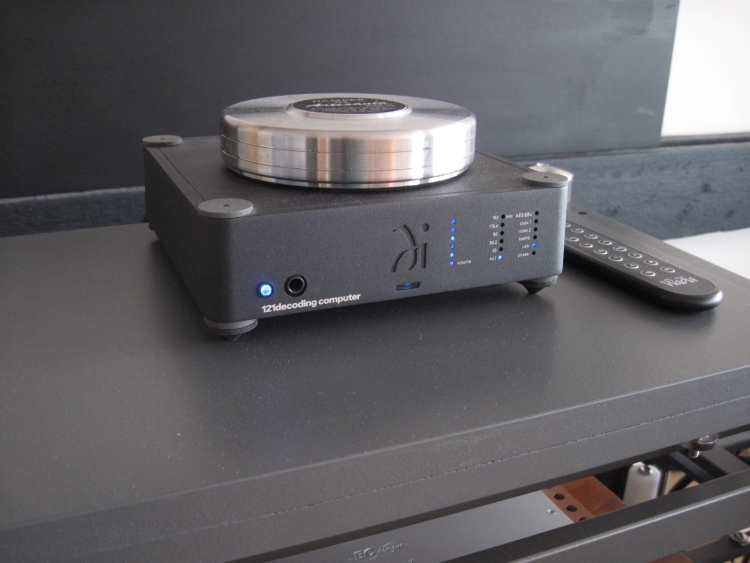
What took me so long?
Retail price 1400 euro in 2014
It took me a while to write a review of the Wadia 121. At its conception, I had already listened to it briefly but could not write about it because it wasn’t officially released yet. At that time I was slightly disappointed because it did not have the classical Wadia sound. Meanwhile, I’ve owned one for almost 2 years. It was purchased to function as the hub in a computer audio setup, connected between a PC and Genelec 8050 studio monitors. While it performed its task splendidly there, not once did I feel the need to compare the 121 with the dearer DACs in the main setup. The 121 has done service in reviews of other products, and did not fare too well compared to the Accuphase E260‘s built-in DAC card. After that experience, I more or less left it sitting idle.
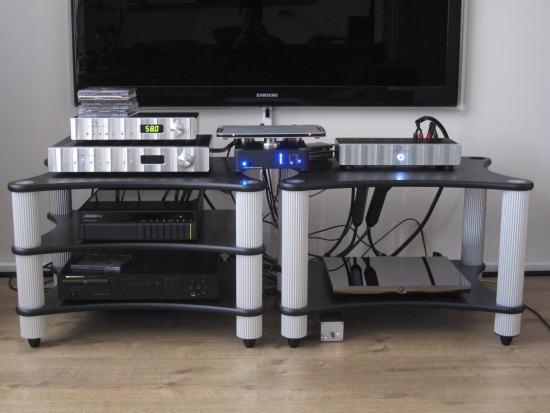
That is until it was used again in a recent review of the latest Jeff Rowland pre-power combination. This was a difficult review to write, as I struggled to make the components sound good. The 121 was blamed and substituted with the brilliantly transparent EC Designs Mosaic but that only shifted the balance. Finally, a Wadia 861 CD player was brought in and although this player sounded better, most notably in bass articulation and heft and dynamic expression, the 121 was not exactly declassified. It just presented music with a different balance.
Meanwhile, I have sold my former reference Jeff Rowland Aeris DAC in order to release funds for making other investments, and this has cleared the road for new DAC experiments. It is against this backdrop that I have finally connected the 121 in the main setup to really assess its qualities and although it’s now a bit late to mention it must be said that I have underestimated it from the start.
SP/DIF and USB Considerations
In preparation for the Wadia 322 that is expected for review, I borrowed the Wadia 25 from the friend to whom I sold the DAC so long ago. The 121 was compared to the 25 using the same cables: Furutech Alpha 3 powercord and Cardas Hexlink Golden 5C interlinks, using the Aurender N10 music server as a source. Both the 25 and 121 were set to maximum output internally, and with the digital volume set to 100%. Normally I preach Asynchronous USB to be the best connection but lately, I’m not so sure anymore. It seems that it depends on the implementation and the synergy, or lack thereof, in the rest of the system. The Rowland Aeris was the first DAC where I noticed that SP/DIF in itself is not actually evil and can be considered just as good as USB, only different. The same was true for the EC Designs Mosaic, and once again this seems to be true for the Wadia 121.
The 121 arguably still sounds most neutral using USB, in my case with an AudioQuest Diamond. Coaxial digital however counters with a more solid bottom end which I always like, and especially when using the Mad Scientist Heretical Digital Cable, the format has a nice balance of solid bass, spaciousness and treble air. As the Wadia 25 only has SP/DIF, further comparisons will be using its coax input.
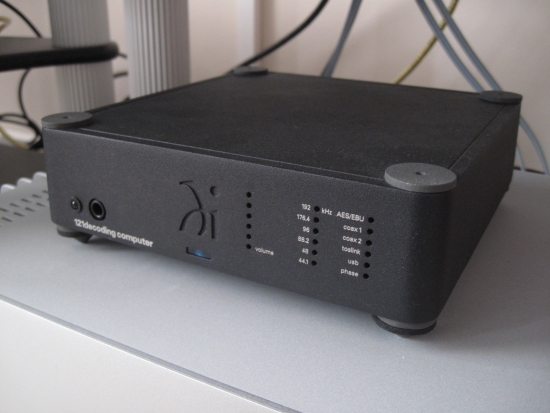
Wadia evolution
Wadia is known for offering state-of-the-art digital products, and for restarting their business in equal measure. Company ownership has changed hands a few times, and currently, they are quite a different company. In 2011 Fine Sounds Spa, owner of Sonus Faber Spa and Audio Research Corporation, announced that it had aquired Wadia Digital. As I understand it current Wadia products are built in the McIntosh factory but still run the famous DigiMaster software. I don’t know this for a fact but I believe that the 121 could be seen as one of the first components produced under the new ownership and this shows twofold. Firstly the 121 is far more affordable than any of the classic Wadias ever were. Secondly, it has quite a different sonic signature.
The sound of digital
The Wadia 25 can be quite dry in the treble but also has rock-solid bass, lots of power and excellent drive in return. In fact, the 25 joins my personal ranks for most impressive bass along with the Wadia 27 and 861, PS Audio PWD MKII and Jeff Rowland Aeris. But as in life, when one excells in a particular area, another area is normally less evolved. With classic Wadias this “less evolved” area is in the ultimate resolution and treble fluidity. I tend to hear that certain qualities span the entire frequency range, meaning for example that when the bass is very accurate, the treble is, too. And perhaps this can be taken too far. Then again, the EC Designs Mosaic is a NOS, filter-less design, highly focused on delivering the absolute lowest distortion. And yet it has the most fluid, gentle and airy treble reproduction that I have heard from a DAC. But the Mosaic does not come close to classical-Wadia’s visceral bass reproduction.
It is my theory that when the bass is reproduced squarely and accurately then this is desirable. But when the treble is too, then depending on the rest of the system, you can start hearing the digital nature of the sound, or at least this seems to be the case when dealing with certain digital filters.
More recent Wadia such as the 27 and 861 are a little smoother in the treble and the last CD products such as the S7i have the most open and airy treble of all Wadias so far, but they also sound less voluptuous in the bass. In generic it could be said that the Wadia sound evolved from dark and extremely solid to more neutral and more balanced.
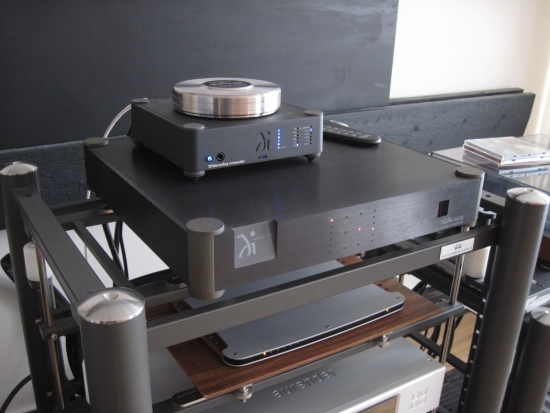
Above: the weight on top is made by Artesania and is usually used for damping resonant enclosures. In this case, it is used to keep the 121 down, preventing heavy cables making the 121 perform a wheely on its rear feet. At this angle, its blue leds seem fine, but when viewed at dead center, they are absolutely blinding. Although they can be dimmed, they are quite piercing even at the dimmed setting.
Wadia 121
The 121 is voiced more in line with the latest Wadias, meaning that it is not particularly dark or dry. In fact it has nicely open and airy treble, with an overall smoothness and fluidity that I do not hear with older Wadias. When comparing the 121 and the 25 it is very easy to hear the differences but both really have their respective areas where they are better than the other. The 25 clearly has superior bass and timbral accuracy but the 121 is much more forgiving and sounds so much smoother. The 121 also seems to have more resolution, especially in the higher frequencies.
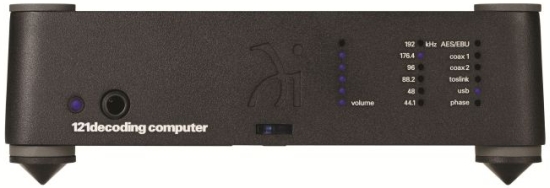
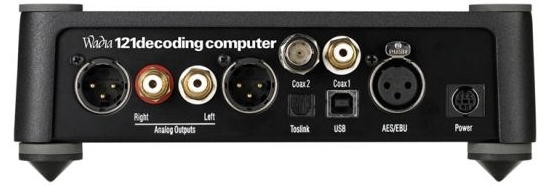
While the 121 doesn’t sound as recognizably Wadia-esque as the classic components, there’s still evidence of the Digimaster algorithm at work. This I believe is in the fulness of tonality and the transient behavior. While not as robust as classic Wadias such as the 25, the 121 still sounds fuller than for example the EC Designs Mosaic. The latter has superior resolution and transparency but the 121 counters with more drive and dynamic slam. While the 121 is unusually fluid for a Wadia, its treble is still somewhat dry at times. In Wadia speak, this is a necessary evil, to allow the DAC to be very good in other areas such as phase coherence. The treble dryness shouldn’t be overexaggerated though. Due to my speakers’ foil-based nature (Martin Logans and Apogees) this aspect seems to be made more obvious than on more traditional speakers.
Conclusion
At 1400 euro, the 121 is not a reference class DAC, and it should not be judged as such. The Wadia 25 beats it in terms of bass articulation, timbre, and overall powerful delivery. I als also deeply impressed with the EC Designs Mosaic DAC’s naturalness, treble refinement and transparency. Still, when switching to the 121 there is not so much a feeling of stepping down, rather one of a change in character. The 121 strikes a very good balance between classic Wadia virtues and newfound smoothness, and this makes the DAC very engaging and very easy to listen to. There are cleaner and more detailed DACs around, but at this price level, I think the 121 has little competition when you are after a Wadia-typical robust delivery. The only DAC that springs to mind with similar sonics is the PS Audio NWD. Naturally, there’s the 122 but I have not heard it yet, and at around 2000 euro it’s in a different price category.
I wonder what would happen if the concept of the 121 was taken a lot further, for instance by substituting the switched power supply with a linear power supply… did anyone say 322?
Update 2020
I highly recommend trying the Teradak external power supply. It addresses the 121’s less well-developed areas such as bass solidity and impact and improves these significantly while adding a fuller, more natural timbre, wider soundstaging, all the while retaining the 121’s inherent strong areas.
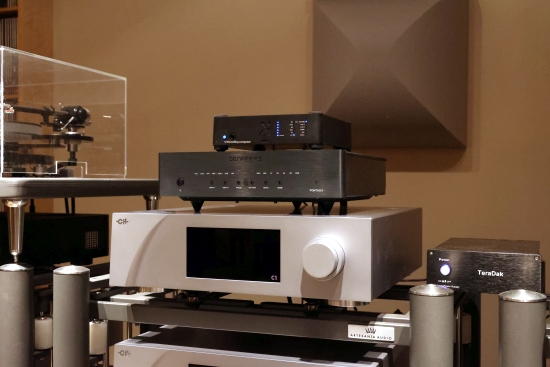
Update 2022
After having reviewed four Denafrips DACs, a friend wondered if it was time to upgrade his Wadia 121. e brought it along together with the Teradak power supply and we compared it with the Denafrips Pontus. Well, that was an easy one: the Denafrips is truly better in every respect. It is more linear, faster, more transparent, more articulate, has better definition and much higher resolution, and a lot more refinement. The only aspect that still speaks well for the 121 is its tonally full sound. It has a very natural timbre and is not leaning toward analytical, let alone the clinical. It has a smooth and friendly charactedr that aims to please rather than dissect.
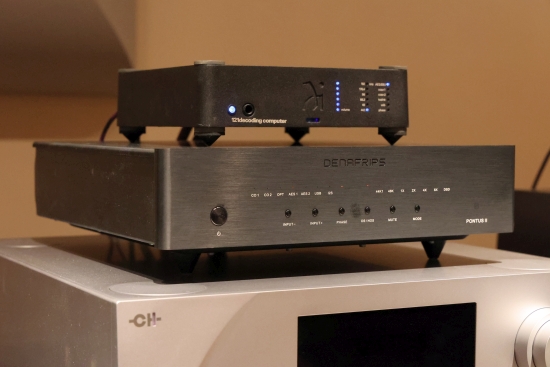
The Pontus is much more analytical but of all the Denafrips DACs, it is the fullest-sounding and while it is highly revealing, it avoids sounding overly controlled, thin, or in any way clinical. At this stage, I can no longer truly recommend the Wadia 121 unless one’s budget simply does not stretch beyond the Wadia’s friendly second-hand prices.
Read Also
Wadia 121 in context of a computer setup with Genelec 8050s
Wadia 521
Wadia 25






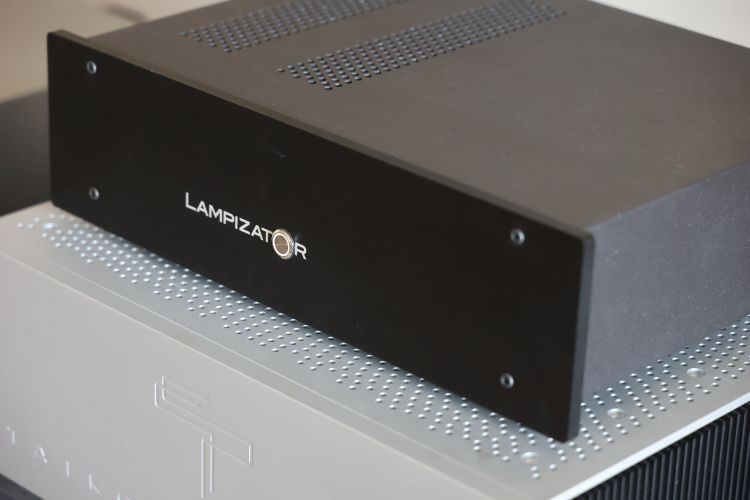
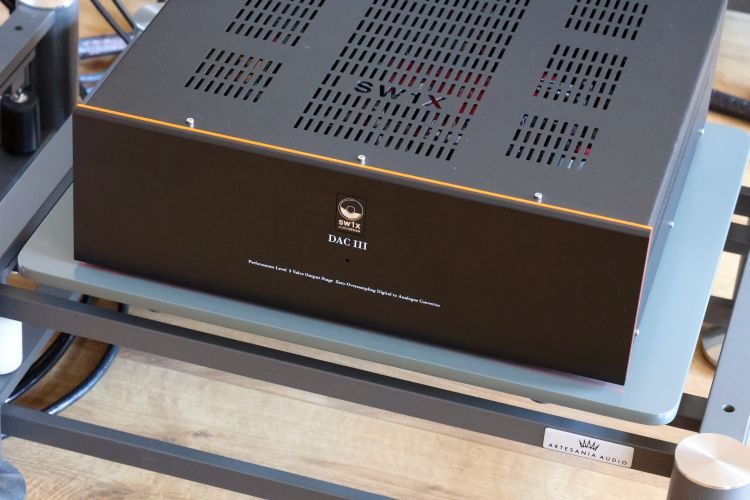
Hi Christiaan,
I own a Wadia 121 and run it directly from my computer. From what I’ve read the DAC technology has improved quite a lot during the last years. I’m looking for a replacement in the 1-3k range; obviously the lower the better, excellent for Jazz, female voices, orchestral and rock. A DAC that sounds natural, without listening fatigue. I’ve been told that DACs can’t compare with proper CD transports. Is this still true for ‘afforable’ DACs?.
My files are mostly redbook but I’m becoming interested in Tidal and maybe convert to DSD with hqplayer, if that improves the quality, as in the matrix x-sabre review.
I’m very tempted with the R2R DACS, but they are very expensive and even you were a bit puzzzled with the Pavane. Maybe the Aqua La Voce S3 (not S2) could work if I get a good deal, but I don’t know how many steps below is from the expensive La Scala MKII optologic.
I’m looking as well at the Brooklyn DAC+, RME ADI-2, and Matrix x-Sabre pro but not sure whether they are a significant jump in quality with respect to my Wadia 121 in spite of the years.
Some people find that DACs cannot compete with CD transports because the latter tend to sound smoother and more fluid. This could be seen as a benefit but also as a sign that there may be too much rounding going on in the transports. Especially classic swing-arm transports such as the Philips CDM1 and CDM4 sound super-relaxed but I can also hear that the transients are definitely rounded off, which is likely a result of components having gone off spec over the course of time. Still, these transports can give very pleasing results, making computer sources sound hard, square or harsh in comparison. Other people find CD transports better because they (more modern ones, other than the aforementioned classic CDM’s) can actually also sound more dynamic and more “free” than some computer sources, the worst of which can sound a little compressed, even if they are otherwise very smooth and friendly. A smooth-sounding music server such as the AudioAanZee Reference Flow causes no listening fatigue but is also not very exciting. So, it’s a matter of knowing what you’re after, to be able to decide if computer sources are indeed a good option or if you’d rather stay with CD transports. Also, “natural” means different things to different people. Ask yourself: does the 121 sound natural to you using the computer source? And what is it in particular that you seek to improve? One thing I can say is that it takes considerable effort and money to make a very good computer source. It’s easier and cheaper to make a very good CD transport.
Hi-res is not really my thing. Although it’s easy to hear the improvement in resolution (with the right files), I rarely found that this actually increased my emotional response. That has more to do with timing, dynamics, timbre and transient behavior. Other people swear by it. YMMV. All I can say is that hi-res does not equal a more analog sound, or causes less listening fatigue per se. DSD files do seem to make some bitstream DACs sound better, though. But not in all cases. I wouldn’t worry about it too much but would try to obtain a multi-bit DAC. If a good ladder DAC is too much then a chip-based multibit DAC is also a great option. Do note: ladder DACs are usually very accurate which in some systems can lead to a cleaner sound than what one was used to. This is simply the result of a much cleaner conversion with much fewer side effects but not everyone prefers this. The Pavane, in hindsight, has a similar overall sound to the Aqua Formula but for some reason I found it to sound too reticent, too withdrawn. I’ve not heard any other Aqua DAC than the Formula xHD but I would not be surprised if their more affordable options also sound very good. I believe they all receive very good reviews.
I’ve not heard the Brooklyn or RME but would think they are good alternatives, if perhaps not significantly better than the 121. On that note, the 121 is a Wadia but it is the first that deviates in sound. It does not have the classic Wadia sound but is much smoother and more relaxed, but still with pretty good bass. If you’d go to the Pavane or Formula xHD then the sound would become considerably cleaner, much more articulate and with much more detail and refinement but also a lot less creamy. The x-Sabre pro is actually pretty good but I found it great only with DSD. If Redbook is your main source then I would advise looking elsewhere. BTW if your budget can stretch a little further then a second hand Bricasti M1 would be a very significant step up while retaining the overall sound balance that you are now used to.
wow, this is an amazing answer!. Many interesting things to digest. I wish reviews and knowledgeable comments were so clear as this. I really appreciate it.
Glad I can help!
Hi Christiaan
does Teradak LPSU also improves that slight dryness in higs?
It does indeed. Pretty much any nice LPSU will improve on the standard PSU with fuller bass, smoother mids and more relaxed treble.